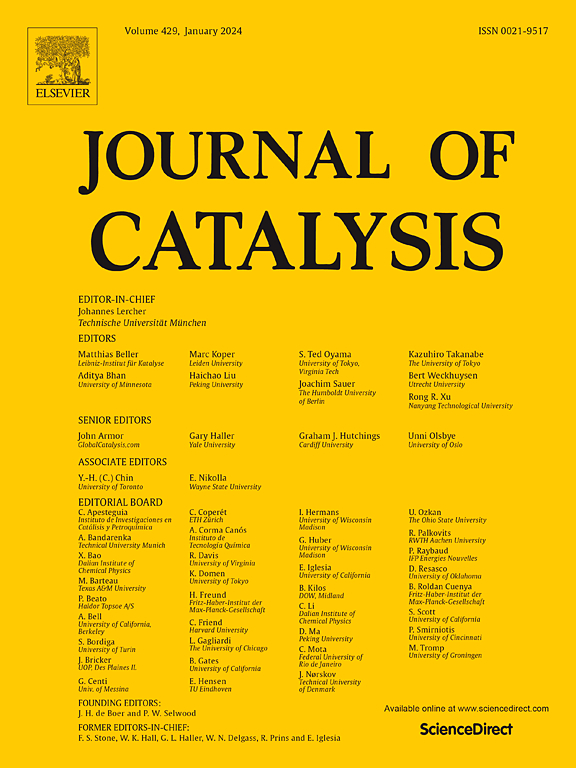对称结构分子半氢化铜基催化剂的尺寸依赖性
IF 6.5
1区 化学
Q2 CHEMISTRY, PHYSICAL
引用次数: 0
摘要
确定铜活性组分的大小依赖行为是实现对称结构分子中碳-氧键半氢化的关键。以草酸二甲酯(DMO)半加氢反应为典型,为生产高附加值材料的重要原料乙醇酸甲酯(MG)提供了一条有前景的途径。本文通过理论研究,阐明了结构敏感性,强调了电子结构和几何结构在Cun/CeO2催化剂上的反应机理中的重要作用。具有“脊状”结构和双位(Cu0-Cuδ+)的Cu4簇在DMO半加氢制MG过程中表现出最好的性能,与实验结果一致。小Cu簇的电子结构通过影响Cu的空d轨道和CO基团的π轨道之间的供体-受体相互作用强度来影响MG的选择性。相反,空间位阻在较大的Cu簇上诱导酰基物质的向下构型,减少了MG解离过渡态的泡利斥力,并促进了MG的进一步加氢。研究结果为对称结构分子半氢化反应中设计最佳粒径和形态的催化剂提供了合理的指导。本文章由计算机程序翻译,如有差异,请以英文原文为准。

Size dependence over Cu-based catalysts for semi-hydrogenation of symmetric-structured molecules
Identification the size dependence behavior of copper active species are crucial for achieving semi-hydrogenation of carbon–oxygen bonds in the symmetric-structured molecules. Semi-hydrogenation of dimethyl oxalate (DMO) was used as typical for investigation, providing a promising pathway for the production of methyl glycolate (MG), an important feedstock for high value-added materials. Here, by employing a theoretical study, we elucidated the structure-sensitivity and emphasized the vital role of electronic and geometric structure in the reaction mechanism over Cun/CeO2 catalysts. The Cu4 cluster with a “ridge-like” structure and dual sites (Cu0-Cuδ+) exhibited the best performance for semi-hydrogenation of DMO to MG, agreed with the experimental results. Electronic structure of small Cu clusters influences MG selectivity by affecting the strength of donor–acceptor interactions between empty d orbitals of Cu and the π orbitals of C![]() O group. In contrast, steric hindrance induces a downward-directed configuration of acyl species on larger Cu clusters, reducing the Pauli repulsion in the transition state of MG dissociation, and promoting undesired further hydrogenation of MG. Our findings provided a rational guideline for designing catalysts with optimal particle size and morphology in the semi-hydrogenation of symmetric-structured molecules.
O group. In contrast, steric hindrance induces a downward-directed configuration of acyl species on larger Cu clusters, reducing the Pauli repulsion in the transition state of MG dissociation, and promoting undesired further hydrogenation of MG. Our findings provided a rational guideline for designing catalysts with optimal particle size and morphology in the semi-hydrogenation of symmetric-structured molecules.
求助全文
通过发布文献求助,成功后即可免费获取论文全文。
去求助
来源期刊

Journal of Catalysis
工程技术-工程:化工
CiteScore
12.30
自引率
5.50%
发文量
447
审稿时长
31 days
期刊介绍:
The Journal of Catalysis publishes scholarly articles on both heterogeneous and homogeneous catalysis, covering a wide range of chemical transformations. These include various types of catalysis, such as those mediated by photons, plasmons, and electrons. The focus of the studies is to understand the relationship between catalytic function and the underlying chemical properties of surfaces and metal complexes.
The articles in the journal offer innovative concepts and explore the synthesis and kinetics of inorganic solids and homogeneous complexes. Furthermore, they discuss spectroscopic techniques for characterizing catalysts, investigate the interaction of probes and reacting species with catalysts, and employ theoretical methods.
The research presented in the journal should have direct relevance to the field of catalytic processes, addressing either fundamental aspects or applications of catalysis.
 求助内容:
求助内容: 应助结果提醒方式:
应助结果提醒方式:


